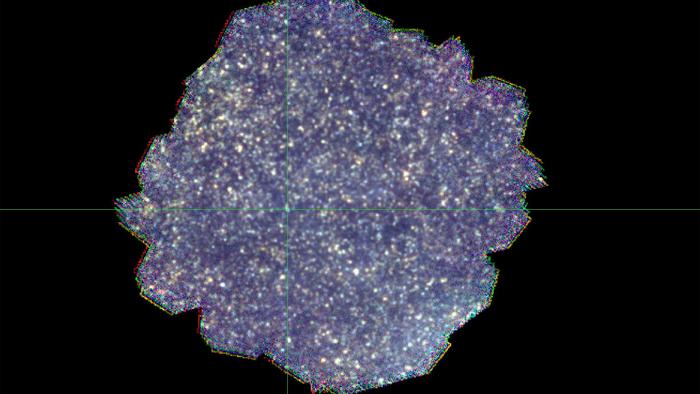Astronomers have made significant strides in understanding the complexities of the universe with the recent discovery of what appears to be a population of elusive galaxies hidden in the vastness of space. These galaxies are believed to hold critical insights into the evolutionary processes of cosmic structures, potentially revolutionizing our existing models of galaxy formation and distribution. With the confirmation of these findings, they could upend long-held assumptions within the field of astrophysics, reshaping our comprehension of the cosmos.
The impetus for this groundbreaking discovery emerged from the analysis of the deepest-ever image of the universe captured at far-infrared wavelengths. This remarkable image showcases nearly 2,000 distant galaxies, rendering an unparalleled view of previously obscured cosmic phenomena. A collaborative research effort comprising scientists from STFC RAL Space and Imperial College London has unveiled this deep cosmic landscape, acknowledged as a monumental feat in contemporary astronomical research.
At the heart of this investigation is the SPIRE instrument aboard the Herschel Space Observatory, which operated from 2009 to 2013. By stacking an extraordinary total of 141 images, researchers successfully enhanced the sensitivity and detail of their observations, thereby revealing structures that were previously hidden from view. The resulting image, heralded as the Herschel-SPIRE Dark Field, surpasses earlier observations in depth by a factor of five, allowing astronomers to scrutinize the dustiest galaxies where stellar formation predominantly occurs.
Dr. Chris Pearson, a lead author on one of the pivotal studies published, emphasizes the significance of their findings by providing context on the nature of the light emitted from these distant galaxies. Approximately half of the universe’s energy output is derived from starlight absorbed by cosmic dust and re-emitted in infrared wavelengths. Thus, understanding these obscure galaxies is essential for constructing a complete picture of the universe’s energy budget.
The impressive depth of the image has led to a crowding of individual galaxies, where their distinct features become increasingly indistinguishable. This complexity posed considerable challenges for researchers, compelling them to develop innovative analytical techniques to extract invaluable data. Thomas Varnish, a PhD student at the Massachusetts Institute of Technology and lead author on the second associated study, highlighted the importance of statistical methods in addressing the challenges posed by this image’s overcrowded nature.
Through meticulous modeling and analysis of the blurred regions of the image, the research team identified potential evidence for a new population of faint galaxies that conventional observational methods had previously overlooked. The implications of such a discovery are profound and could significantly alter our understanding of galactic evolution and the formation processes underpinning these celestial bodies. If confirmed, this hidden population could disrupt existing paradigms governing galaxy number distribution and cosmic evolution theories.
The excitement generated by these findings also underscores the importance of the Herschel Space Observatory’s legacy, particularly as it continues to yield groundbreaking results over a decade after its operational phase concluded. Dr. David Clements, another key contributor to this research, articulates the value contained within the Herschel archive, which provides a treasure trove of data still ripe for exploration and analysis.
To further validate their intriguing findings, the researchers anticipate utilizing telescopes that operate across various wavelengths to ascertain the existence and nature of these potential new galaxies. This pursuit is not merely a scholarly endeavor; it represents a critical step toward demystifying the intricate processes governing the formation and evolution of galaxies throughout cosmic history.
As astrophysicists endeavor to piece together this cosmic puzzle, they hope to illuminate the nature of these faint, dusty galaxies and their contributions to the overall framework of cosmic evolution. Dr. Pearson’s assertion that current optical observations capture only half of the universe’s intricate story underscores the necessity of broadening our observational techniques to include infrared wavelengths, thereby enhancing our understanding of the cosmos.
The quest for knowledge in this domain is ongoing, and as researchers delve deeper into these far-infrared observations, they strive to discover the hidden dimensions of the universe that remain veiled by interstellar dust and enigmatic forces. The proposed upcoming mission, dubbed PRIMA, is expected to bridge critical gaps in our observational capabilities, thereby enabling scientists to explore far-infrared phenomena in greater detail.
In conclusion, these recent discoveries signify a remarkable advance in the field of astrophysics, with the potential to redefine our understanding of galaxy formation and evolution. If acknowledged and confirmed, this concealed population of galaxies could reshape the fundamental frameworks that underpin modern cosmological theories, ultimately leading to a more nuanced appreciation of the intricate workings of the universe.
Subject of Research: Hidden galaxies in the universe
Article Title: The Herschel-SPIRE Dark Field I and The Herschel-SPIRE Dark Field II
News Publication Date: April 10, 2025
Web References: Monthly Notices of the Royal Astronomical Society
References: Pearson et al. (2025), Varnish et al. (2025)
Image Credits: Chris Pearson et al.
Keywords: astronomy, galaxies, Herschel Space Observatory, SPIRE instrument, far-infrared wavelengths, cosmic evolution, dark matter, star formation, cosmic dust, astrophysics, observational techniques.




